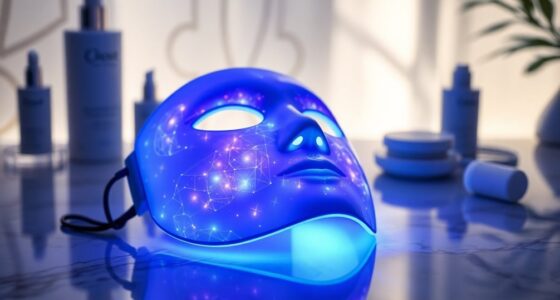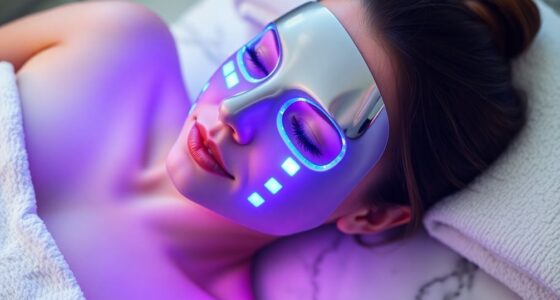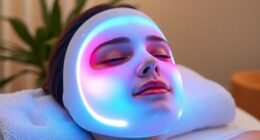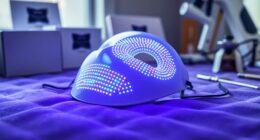Yes, LED face masks can work for improving your skin. They use red light to boost collagen production and blue light to target acne-causing bacteria. However, the effectiveness varies based on your skin type and requires consistent use, typically about five times a week. While at-home devices are convenient, they may not offer the same results as professional treatments. If you’re curious about how to maximize their benefits, you’d want to explore more insights on their usage.
Key Takeaways
- LED face masks utilize light therapy, with red light promoting collagen production and blue light targeting acne-causing bacteria.
- Consistent use, approximately five times a week, can yield noticeable improvements in skin texture and appearance.
- At-home LED masks are less powerful than professional treatments but offer convenience for regular skin therapy.
- Safety precautions, like eye protection and following usage guidelines, are essential to minimize risks such as irritation.
- Results may vary based on individual skin types and device quality; consultation with a dermatologist is advisable for optimal outcomes.
Overview of LED Face Masks
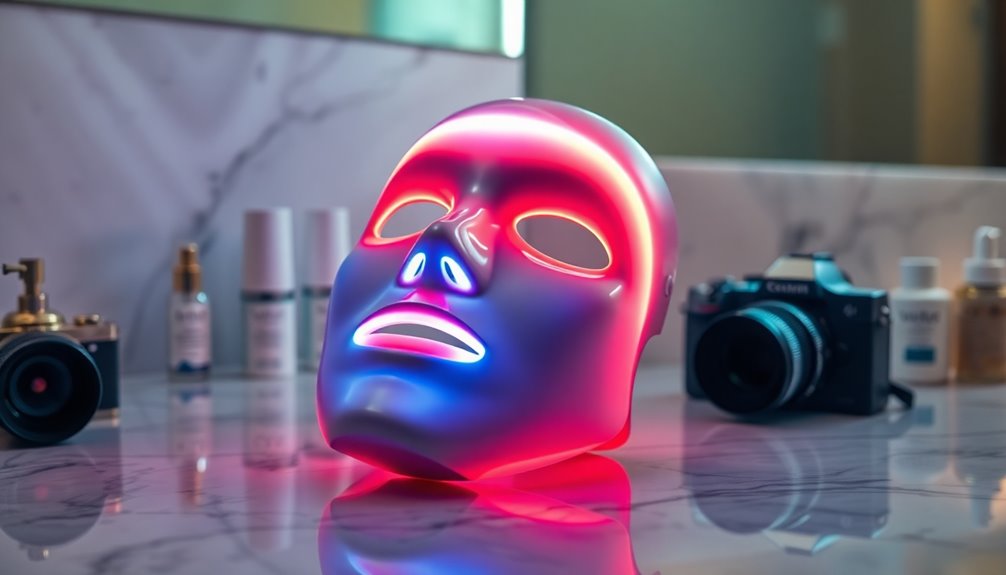
If you’re looking for a convenient way to improve your skin, LED face masks might be worth considering. These at-home devices utilize light therapy to target various skin conditions.
Primarily, they employ red light LED to boost collagen production and reduce wrinkles, while blue light works to eliminate acne-causing bacteria. Designed for comfort, you can wear these masks while relaxing, featuring eye and mouth holes secured with straps.
Prices vary greatly, from under $50 to nearly $2,000, reflecting differences in technology and effectiveness. Many LED face masks are FDA cleared, enhancing their appeal.
The growing popularity of these masks is largely driven by social media and a rising interest in non-invasive skin treatments, making them a trendy choice for skincare enthusiasts.
Mechanism of Action and Efficacy
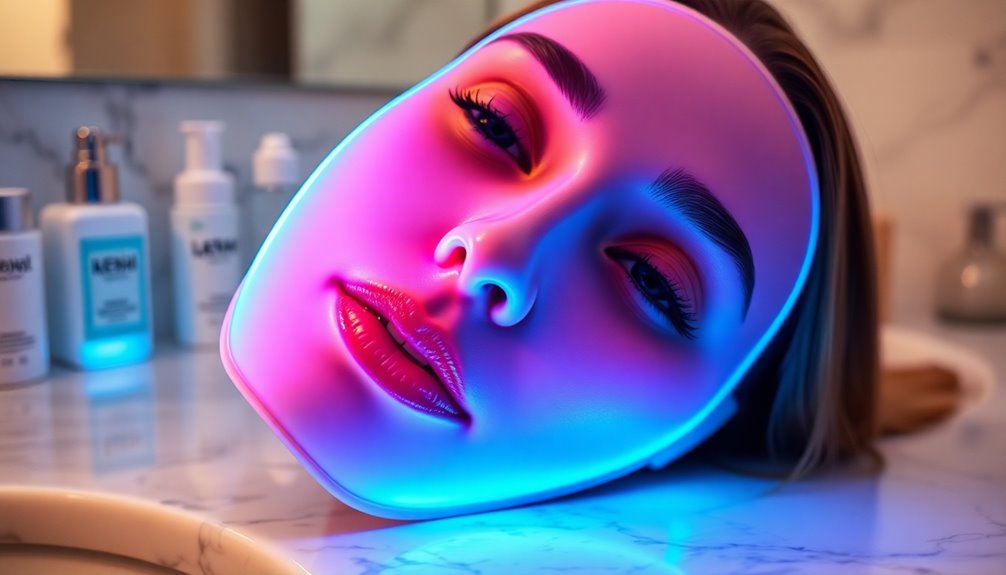
LED face masks work by utilizing specific wavelengths of light to penetrate the skin and stimulate cellular activity. Red light therapy (630-660 nm) enhances collagen production, reducing wrinkles and fine lines, while blue light therapy (405-420 nm) targets acne-causing bacteria and regulates oil production.
| Light Type | Benefits | Efficacy |
|---|---|---|
| Red Light | Boosts collagen, reduces wrinkles | Visible improvements |
| Blue Light | Eliminates acne bacteria | Effective for oily skin |
| At-Home Devices | Convenient, but less powerful than pro | Cumulative effects over time |
| Skin Type Impact | Results vary based on skin type | Consistency is key |
Regular use is essential for noticeable changes, with cumulative effects enhancing overall skin conditions.
Benefits of Red and Blue Light Therapy
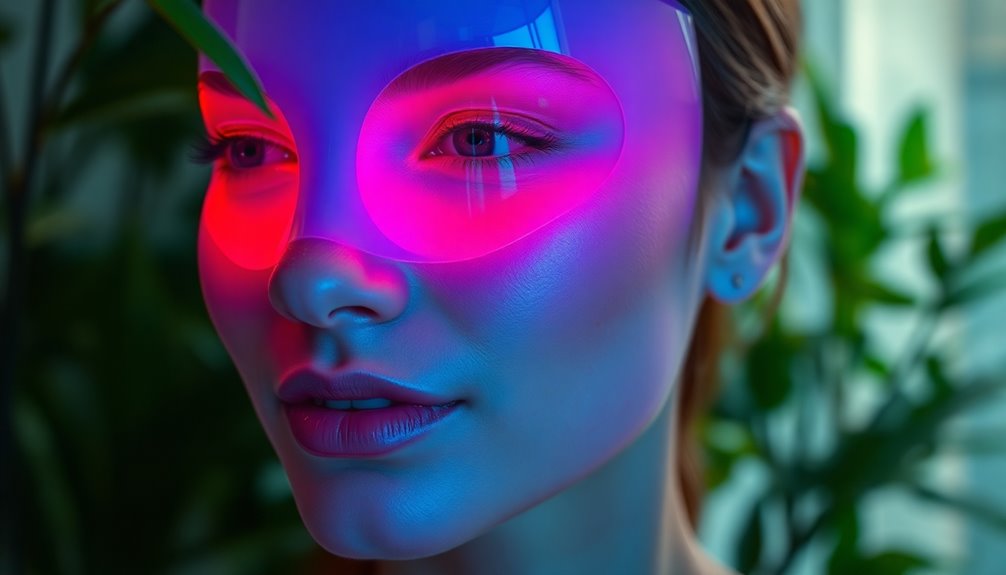
While exploring skincare options, many find that red and blue light therapy offers significant benefits for various skin concerns.
Red light therapy penetrates deeply, boosting collagen production and enhancing skin strength, which helps reduce fine lines and wrinkles. It also effectively reduces inflammation and accelerates healing for various skin conditions.
On the other hand, blue light therapy targets acne-causing bacteria, effectively reducing acne lesions and preventing future breakouts.
Regular use of LED masks featuring both therapies can lead to subtle improvements in skin texture and overall appearance. Plus, these therapies are safe for various skin types, making them accessible to almost anyone.
Just remember to follow manufacturer instructions and consult with a dermatologist for personalized advice.
Safety Considerations and Risks
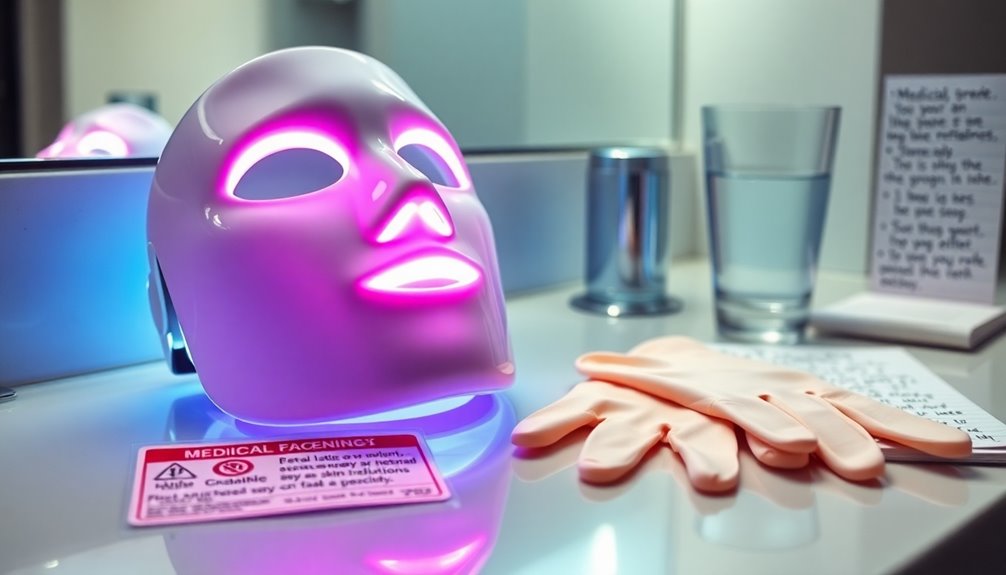
Although many people enjoy the benefits of LED face masks, it’s crucial to take into account safety precautions before diving in. If you have light sensitivity, consult a dermatologist first to avoid complications. Additionally, it’s important to be aware of common LED face mask usage mistakes, such as using the mask for longer than the recommended time or not properly cleansing your skin beforehand. These missteps can lead to suboptimal results or even skin irritation. Always read the manufacturer’s instructions carefully and consider patch testing the device on a small area of your skin to ensure it is compatible with your skin type.
Always use eye protection, especially with blue light masks, to prevent potential eye irritation or damage. Be aware of possible side effects like redness and irritation; overusing LED face masks can increase inflammation.
Stick to manufacturer guidelines to guarantee safe usage. Long-term safety data on at-home devices is limited, so pay attention to your skin’s response and stop using the mask if you notice adverse effects.
Additionally, individuals with darker skin tones might face a higher risk of discoloration, highlighting the need for more research.
Evaluating the Value of At-Home LED Face Masks
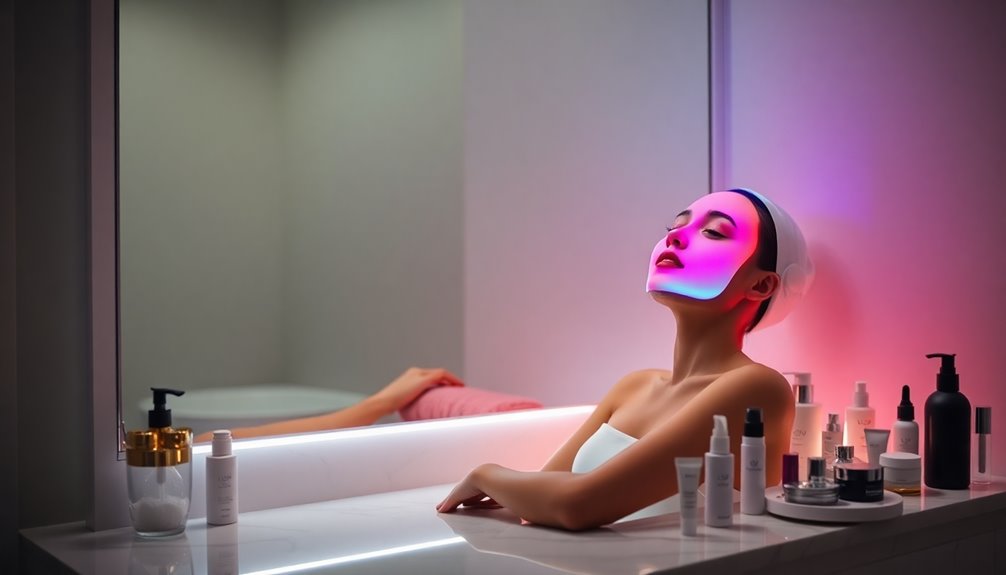
Are at-home LED face masks truly worth the investment? While these devices can aid in skin therapy and promote collagen production, results vary based on device quality and individual skin conditions.
Clinical studies show that consistent use—about five times a week for at least a month—can help reduce fine lines and improve skin texture. However, you mightn’t see dramatic changes, as at-home LED masks generally aren’t as effective as professional treatments.
Light therapy uses different wavelengths; red light targets aging, while blue light addresses acne. Though they’re safe in the short term, be cautious of high price points versus mild results. Additionally, incorporating natural alternatives like hibiscus can enhance the overall effectiveness of your skincare routine.
Ultimately, weigh your options before diving into at-home LED face masks.
Frequently Asked Questions
Does LED Face Mask Therapy Actually Work?
Using an LED face mask is like watering a plant; with consistent care, you can see it flourish.
When you ask if LED face mask therapy works, the answer leans toward yes, but it depends on regular use and the quality of the device.
Red light can boost collagen for wrinkles, while blue light fights acne.
Stick to a routine, ideally five times a week, and you might notice some subtle improvements in your skin.
What Are the Disadvantages of LED Mask?
LED masks have their disadvantages.
You might find that they’re less effective than professional treatments, as at-home devices often provide lower intensity.
Excessive use can lead to irritation, redness, or increased inflammation.
Results can vary greatly depending on your skin type and the quality of the device.
If you have deeper skin issues, like cystic acne or scarring, you might feel disappointed with the outcomes, making it essential to manage your expectations.
What Does the Mayo Clinic Say About Red Light Therapy?
Imagine a garden where sunlight nurtures every bloom. The Mayo Clinic suggests red light therapy can act like that sunlight for your skin.
It stimulates collagen production, improves texture, and may help with wrinkles and acne. While it’s safe and non-invasive, you’ll need to be patient. Consistent use is key, as results can vary based on your unique skin.
However, remember, more research is needed to fully understand its long-term benefits.
Do Dermatologists Recommend Red Light Masks?
Yes, dermatologists often recommend red light masks for their potential benefits.
They acknowledge that these devices can improve skin texture, reduce wrinkles, and boost collagen production.
However, they also stress the importance of using FDA-approved masks to guarantee safety and effectiveness.
Regular use is key, as consistent application typically leads to better results.
While at-home masks can be beneficial, in-office treatments usually offer quicker and more pronounced improvements.
Conclusion
To summarize, LED face masks can be a promising tool for enhancing your skincare routine, offering benefits like improved skin tone and reduced acne. For instance, a user named Sarah noticed a significant reduction in her breakouts after consistently using a blue light mask for just a month. However, it’s important to approach these devices with realistic expectations and awareness of potential risks. Always consult with a dermatologist to make sure you’re making the best choice for your skin.


